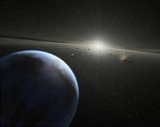
HD 69830 d
Encyclopedia
HD 69830 d is an extrasolar planet
orbit
ing the orange dwarf
star
HD 69830
every 197 day
s. It is the outermost known planet in its planetary system
and possibly lies within its habitable zone.
. The semimajor axis of the orbit is only 0.63 AU
, similar to that of Venus
. However, HD 69830 is a less massive and energetic star than the Sun
, thereby putting the planet within its habitable zone
.
with no solid
surface. Since the planet has only been detected indirectly through its gravitational effects on the star, properties such as its radius
and composition are unknown.
Extrasolar planet
An extrasolar planet, or exoplanet, is a planet outside the Solar System. A total of such planets have been identified as of . It is now known that a substantial fraction of stars have planets, including perhaps half of all Sun-like stars...
orbit
Orbit
In physics, an orbit is the gravitationally curved path of an object around a point in space, for example the orbit of a planet around the center of a star system, such as the Solar System...
ing the orange dwarf
Orange dwarf
A K-type main-sequence star , also referred to orange dwarf, are main-sequence stars of spectral type K and luminosity class V. These stars are intermediate in size between red M-type main-sequence stars and yellow G-type main-sequence stars...
star
Star
A star is a massive, luminous sphere of plasma held together by gravity. At the end of its lifetime, a star can also contain a proportion of degenerate matter. The nearest star to Earth is the Sun, which is the source of most of the energy on Earth...
HD 69830
HD 69830
HD 69830 is an orange dwarf star approximately 41 light-years away in the constellation of Puppis. It has the Gould designation 285 G. Puppis, though this is infrequently used. In 2005, the Spitzer Space Telescope discovered a debris disk orbiting the star. The disk contains substantially more...
every 197 day
Day
A day is a unit of time, commonly defined as an interval equal to 24 hours. It also can mean that portion of the full day during which a location is illuminated by the light of the sun...
s. It is the outermost known planet in its planetary system
Planetary system
A planetary system consists of the various non-stellar objects orbiting a star such as planets, dwarf planets , asteroids, meteoroids, comets, and cosmic dust...
and possibly lies within its habitable zone.
Orbit and mass
The planet's orbit has a low eccentricity, like most of the planets in our solar systemSolar System
The Solar System consists of the Sun and the astronomical objects gravitationally bound in orbit around it, all of which formed from the collapse of a giant molecular cloud approximately 4.6 billion years ago. The vast majority of the system's mass is in the Sun...
. The semimajor axis of the orbit is only 0.63 AU
Astronomical unit
An astronomical unit is a unit of length equal to about or approximately the mean Earth–Sun distance....
, similar to that of Venus
Venus
Venus is the second planet from the Sun, orbiting it every 224.7 Earth days. The planet is named after Venus, the Roman goddess of love and beauty. After the Moon, it is the brightest natural object in the night sky, reaching an apparent magnitude of −4.6, bright enough to cast shadows...
. However, HD 69830 is a less massive and energetic star than the Sun
Sun
The Sun is the star at the center of the Solar System. It is almost perfectly spherical and consists of hot plasma interwoven with magnetic fields...
, thereby putting the planet within its habitable zone
Habitable zone
In astronomy and astrobiology, a habitable zone is an umbrella term for regions that are considered favourable to life. The concept is inferred from the empirical study of conditions favourable for Life on Earth...
.
Characteristics
Given the planet's Neptune-type mass, it is likely that HD 69830 d is a gas giantGas giant
A gas giant is a large planet that is not primarily composed of rock or other solid matter. There are four gas giants in the Solar System: Jupiter, Saturn, Uranus, and Neptune...
with no solid
Solid
Solid is one of the three classical states of matter . It is characterized by structural rigidity and resistance to changes of shape or volume. Unlike a liquid, a solid object does not flow to take on the shape of its container, nor does it expand to fill the entire volume available to it like a...
surface. Since the planet has only been detected indirectly through its gravitational effects on the star, properties such as its radius
Radius
In classical geometry, a radius of a circle or sphere is any line segment from its center to its perimeter. By extension, the radius of a circle or sphere is the length of any such segment, which is half the diameter. If the object does not have an obvious center, the term may refer to its...
and composition are unknown.

